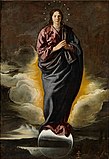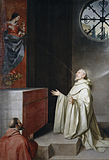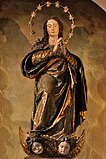
Alonso Cano
Alonso Cano Almansa or Alonzo Cano (19 March 1601 – 3 September 1667) was a Spanish painter, architect, and sculptor born in Granada.[1]
For the metro station, see Alonso Cano (Madrid Metro).
He learned architecture from his father, Miguel Cano;[1] painting in the academy of Juan del Castillo,[1] and from Francisco Pacheco the teacher of Velázquez; and sculpture from Juan Martínez Montañés. As a sculptor, his most famous works are the Madonna and Child in the church of Lebrija (also called Nebrija), and the colossal figures of San Pedro and San Pablo.[1][2]
He was made first royal architect, painter to Philip IV, and instructor to the prince, Balthasar Charles, Prince of Asturias. The King gave him the church preferment of a canon of the Granada Cathedral (1652),[1] in order to take up a position as chief architect of the cathedral. Towards the end of his life, he designed the cathedral façade, which was erected to his design after his death.[3]
He was notorious for his ungovernable temper; and it is said that once he risked his life by committing the then capital offence of dashing to pieces the statue of a saint, when in a rage with the purchaser who begrudged the price he demanded.[2][1] According to another story, he found his house robbed after coming home one evening, his wife murdered, and his Italian servant fled. Notwithstanding the presumption against the fugitive, the magistrates condemned Cano, because he was of a jealous temper.[4] Upon this he fled to Valencia, but afterwards returned to Madrid, where he was put to the torture, which he endured without incriminating himself, and the king received him into favour.[5]
After the death of his wife he took Holy Orders[1] as a protection from further prosecution, but still continued his professional pursuits. He died in 1667. In his last moments, when the priest held to him a crucifix, he told him to take it away because it was badly carved.[6] According to the Catholic Encyclopedia, the dying Cano refused the Sacrament from a priest who gave it to conversos.[1][6]
Works
Works by Cano in the Prado Museum in Madrid include:[10]











